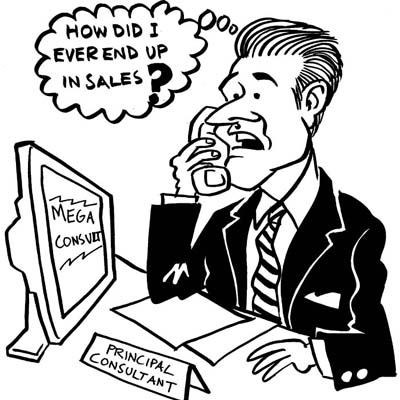
Most sales people hate to cold call. It is frequently considered by many to be the single most stressful part of selling. So much so that many people have given up this noble and proud profession for non-selling positions. There are actually several reasons why sales reps consider cold calling one step below getting a root canal.
Fear of rejection is one of the biggest reasons reps dislike cold calling. After all, who wants to be told “no” all day long? However, there are other reasons that add to the disdain, including not wanting to bother anyone (the “telemarketing” syndrome), gatekeeper resistance, lack of confidence (in themselves, their product, their company, etc.), or they just don’t know how to do it. While these reason are understandable, they are all symptoms rather than causes.
In understanding that we don’t like to cold call, we also have to understand why we have call reluctance. For instance, we may not like rejection, but the reason we are rejected is that we are not approaching it the right way. Or, we get resistance from the gatekeeper or feel like we are bothering people because, again, we aren’t equipped with the skills to perform the duty properly so that we don’t get rejected or bother people.
It comes down to Will and Skill. We, as human beings prone to human nature, avoid things we are not good at, and thus lose the will. If we are good at something we will be more inclined to do it. Hence, when we improve our skills, our will improves proportionately. So, it’s important to understand why we have call reluctance – what are our challenges and why we are reluctant.
Why Cold Calling is Important
Before proceeding with recommendations on how to improve your cold calling, let’s review why cold calling is important. A customer’s buying and decision making process usually goes through several steps. First, they realize they have a problem and identify what the problem is. Second, they calculate the costs associated with the problem. Third, they evaluate alternatives. These first three steps comprise the “Planning Stage”. The next stage is the “Evaluation Stage”. In this stage they talk to vendors to consider alternatives. Once that’s done, they decide on a vendor and move on.
When the customer reaches the Evaluation Stage, to a certain extent they already decided on the approach they want to take. But what if that approach isn’t the right one for them? Or, what if their approach includes preconceived notions that would preclude you from being a contender for their business? When you call them, it’s already too late. You’ve had no inputs into their Planning Stage. As a result, you could be chasing their biases and forgone conclusions when, in fact, they are already leaning in another direction. This is what often happens when you get an RFP (Request For Proposal). The RFP is “wired” to another vendor or at least includes questions that reflect the customer’s biases to another solution. You end up wasting a lot of time responding with your proposal only to find they really knew whom they were choosing all along. If, on the other hand, you caught them in the Planning Stage and positioned yourself as a valued partner, then you could help them in identifying their problems AND alternative solutions.
Now what if you do catch someone in the Planning Stages, but they don’t know they are in that stage yet. In other words, they know they have a problem, but they haven’t consciously decided to do something about it. This is actually a perfect time for a cold call, assuming you handle it correctly. Here is how not to call someone in this situation. Sales Rep: “Hi, my name is Fred Johnson of Acme Software. My company helps businesses with their accounting problems. I was wondering if you had any accounting problems.” Prospect: “No! But thanks for calling. Bye.” Of course they’re going to say no, because they aren’t aware or sure they actually have problems, and hence they don’t have a need for you. Also, you haven’t shown them that you care about their problems. Instead, you simply came across as someone who only cares about selling them something.
If you approached this differently, you could get invited in to help them identify their core issues and explore alternatives. But you can’t come across on the initial cold call as if you are selling something. Instead, you need to position yourself as a trusted advisor by asking the right questions, listening to their answers, and proposing how you might be able to help with the exact pains they just described to you. A better dialogue might be, “Hi I’m Fred Johnson with Acme Software. We specialize in helping businesses improve their customer acquisition and retention. I was calling to see how important improving sales and customer retention are to your business. Do you have a moment for a few questions?”
Be a Boy Scout – Always Be Prepared
You help improve your cold calling by being prepared. We all get calls from sales people who clearly are unprepared and embarrass themselves by trying to “lower your phone bills” when they don’t even know how much you are currently paying for your phone bills. Or they try to sell you office equipment when you work in a shared-office environment and don’t purchase this sort of equipment.
Like most things I do, I have a process, and cold calling is no different. Your cold calling process includes the steps, reasons and outcomes for every call. To begin with, you should always have a clear purpose for the call – Why are you calling? Next, have a goal – What is your desired outcome? Is it to make a sale, schedule a meeting, or get introduced to the decision maker? You also have to remember that in order to get your prospect’s interest, you have to appeal to their needs, wants and desires. So remember WIIFM – What’s In It For Me? Of course, the “Me” in this case is your prospect. Make sure your discussions make it clear that everything you are asking has to do with helping their problem, not with you making a sale.
You also don’t want to preach. This is what those annoying telemarketers do. They “tell” you what it’s all about and try to lead you down their path, which is to buy something, instead of asking what ails you. The key to doing this effectively is to ask questions about the prospect, such as what is currently not working for them, how much it is costing them to continue in this mode of operation, what happens if nothing changes, etc. It helps to use a script as well. Now I’m not suggesting you read from a script. What I mean is write down bullets on the points and questions you want to ask and use that as a guideline so you don’t drift off and digress from your goal. A good script should help you organize your thoughts and keep you on track. It will also help you discuss benefits rather than features.
You should always “warm up” your cold calls by doing research in advance. It is very easy to learn all about a company via the Internet. Read about their company’s background and products. Read their press releases and annual reports. Then when you call, you can refer to something significant about their business which helps break the ice and shows you are interested in them. And, don’t give up. These days it takes 6 to seven calls, maybe more, to get through to someone. The average sales rep gives up after 2 to three calls, not even half-way there. Perseverance is the key.
It also helps to profile your prospects before calling. Know who buys your product, when they buy it, how they buy it, and more. What is their profile? Are they affluent males between the ages of 35 and 49? Are they businesses with less than 100 employees and located in one facility? Are they departments within businesses who can’t readily get the services they need from their corporate offices? Once you know this, you can rank your call list and call the “A” players first, those who match your profile the best. If you use technology to help keep track of this information, which you should, then organize your call list, schedule your follow-ups, and manage your day. You will find that you will be more efficient, effective and successful.
Develop a Call Quota
Finally, as part of your cold calling process, remember not to take “No” personally. They are rejecting your offer, company or product, but not you personally (unless, of course, you upset them, in which case you deserve to take it personally). Accept the fact that you have to kiss a lot of frogs to find your prince. You’re not going to succeed with every call. So don’t set yourself up for disappointment every time someone says they don’t want to meet with you. To help with this, give yourself a “Call Quota”. This is not a quota for how many calls you should make in a day. This involves knowing how many “No’s” it takes to get to a “Yes”.
Let’s say your revenue goal is $100,000. and the average client spends $5,000. To reach your goal, you’ll need 20 new clients. If your close ratio is 25%, you’ll need to call 80 new Prospects, because 25% of 80 is 20, the number of new clients you need. So, with this simple information, simply remember that 60 of those calls will be No. Your goal then is to find the 20 Yes’s and the 60 No’s shouldn’t bother you because you are expecting them.
Cold Calling doesn’t have to be the dreaded, avoid-at-any-cost chore that many sales reps make it out to be. With proper training and planning, it is actually fun and a very necessary step in beginning your sales process.
Good luck and good selling!
 Russ Lombardo is President of PEAK Sales Consulting, LLC and an experienced CRM and Sales consultant, trainer, writer, speaker and radio show host. Russ works with businesses to help improve their customer acquisition and retention for increased revenue and success. Russ is author of the books, “CyberSelling”, “CRM For The Common Man” and “Smart Marketing”. He can be reached at 702-655-5652 and emailed at russ@peaksalesconsulting.com.
Russ Lombardo is President of PEAK Sales Consulting, LLC and an experienced CRM and Sales consultant, trainer, writer, speaker and radio show host. Russ works with businesses to help improve their customer acquisition and retention for increased revenue and success. Russ is author of the books, “CyberSelling”, “CRM For The Common Man” and “Smart Marketing”. He can be reached at 702-655-5652 and emailed at russ@peaksalesconsulting.com.
 I love racquetball. I played racquetball for over 18 years, very aggressively and very competitively. It’s great exercise and a perfect way to let out your aggressions and stress. That’s why I was so upset when my health club decided to forgo customer retention and worry about their own singular requirement – Getting new customers! Yes, I’m actually going to teach a customer retention lesson by discussing my racquetball experience.
I love racquetball. I played racquetball for over 18 years, very aggressively and very competitively. It’s great exercise and a perfect way to let out your aggressions and stress. That’s why I was so upset when my health club decided to forgo customer retention and worry about their own singular requirement – Getting new customers! Yes, I’m actually going to teach a customer retention lesson by discussing my racquetball experience.